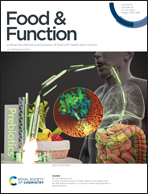Anti-androgenic potential of the fruit extracts of certain Egyptian Sabal species and their genetic variability studies: a metabolomic-molecular modeling approach†
Abstract
This work aimed to evaluate the anti-androgenic activity of S. blackburniana Glazebrook, S. causiarum (O. F. Cook) Becc, and S. palmetto (Walter) Lodd. Ex Schult fruit extracts in rats using Hershberger assay. Furthermore, to annotate secondary metabolites using LC-HRMS technique, to investigate underlying mechanisms responsible for 5-α-reductase inhibitory activity in silico and to compare cytotoxic effects in vitro against human prostatic stromal myofibroblast (WPMY-1) and human benign prostatic hyperplasia (BPH-1) cell lines using MTT, 3-[4,5-dimethylthiazol-2-yl]-2,5-diphenyltetrazolium bromide (spectrophotometrically). The results showed significant anti-androgenic implications with varying degrees, markedly decreased sex organ weights, reduction in testosterone and increase in LH and FSH serum levels. Genetic diversity study ensured the correct genotype and revealed outperformance of SCoT compared with CBDP markers to interpret polymorphism among selected species. S. blackburniana exhibited selective cytotoxic activity against BPH-1 compared to finasteride. Molecular docking of 59 dereplicated metabolites belonging to various chemical classes revealed that helasaoussazine, pinoresinol and tetra-O-caffeoylquinic acid are the top inhibitors of 5-α-reductase-2. Our study provides an insight into the anti-androgenic activity of selected species of Egyptian Sabal supported by docking study for the first time, demonstrates safety toward liver and kidney and highlights a new potential therapeutic candidate for anti-androgenic related disease such as benign prostatic hyperplasia.



 Please wait while we load your content...
Please wait while we load your content...